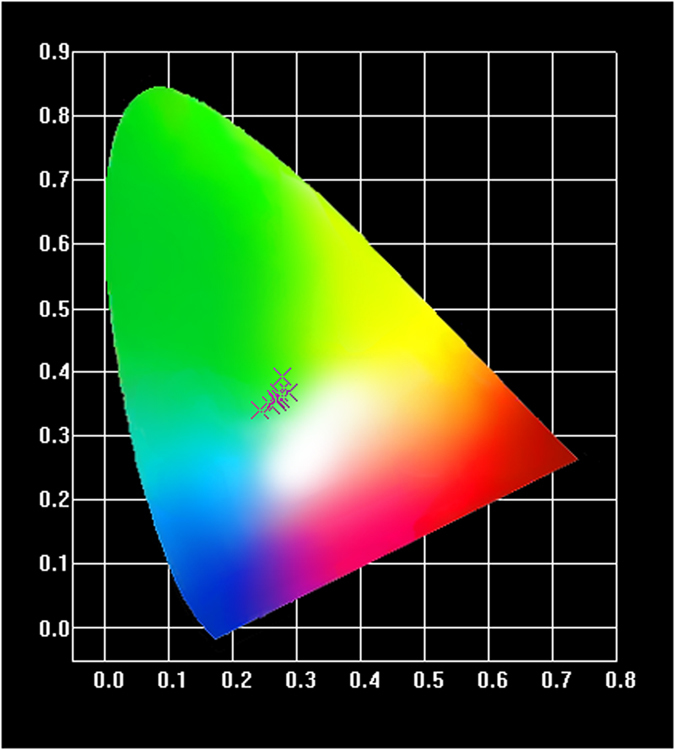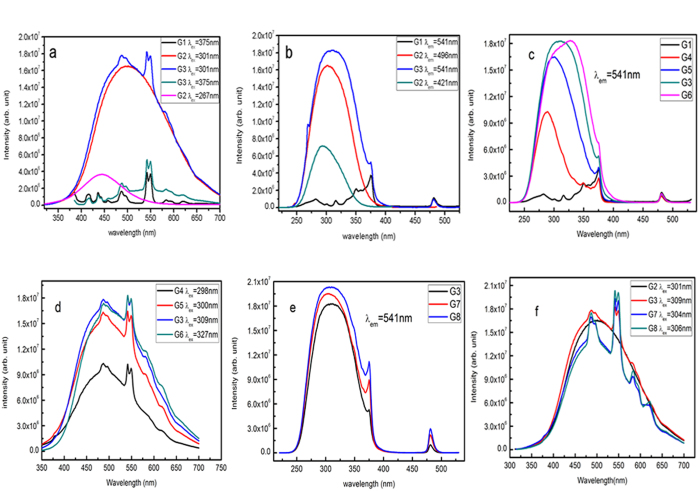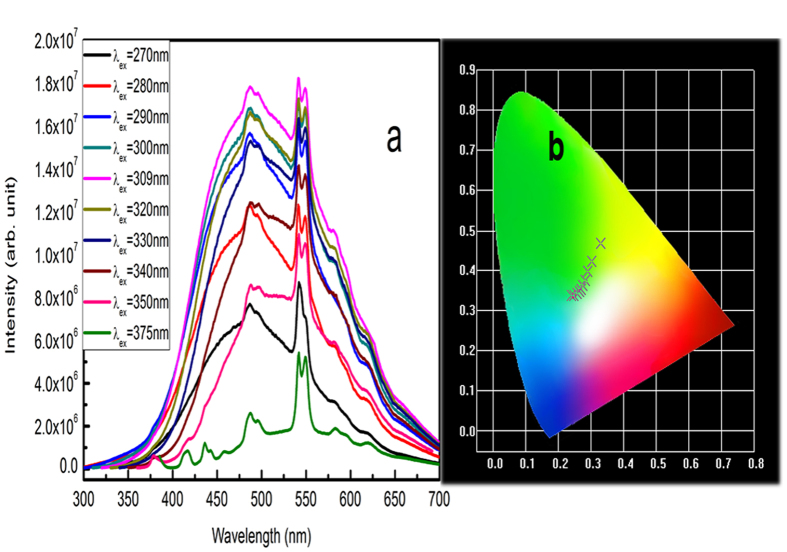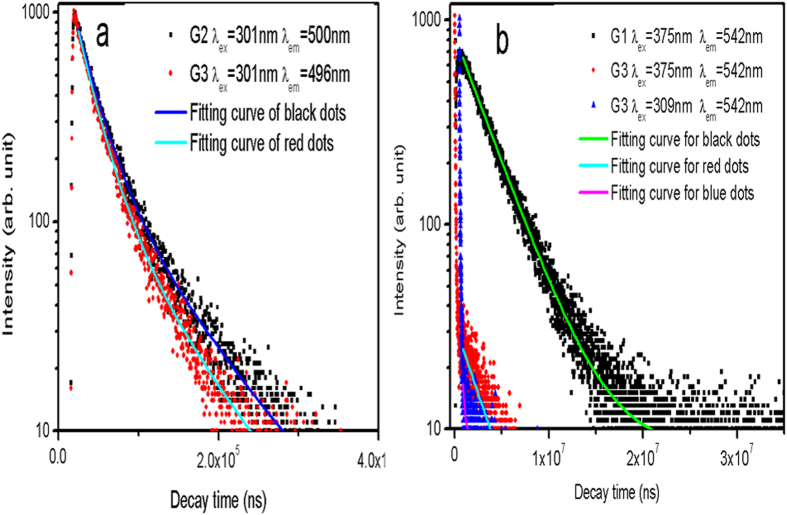Abstract
We present photoluminescence properties of Tb3+ doped borosilicate glasses modified by Cu+. Around 5-time enhanced emission at 541 nm due to the superposed emission of Tb3+ and Cu+ is observed under the deep UV excitation. Excitation spectra demonstrate a greatly increased absorption of Tb3+ ions in the deep UV region towards the Cu+ excitation band, while the shortened Cu+ emission lifetime of glasses in association with presence of Tb3+ ions implies an energy transfer process from Cu+ to Tb3+ ions. Meanwhile, the Tb3+ emission lifetime is significantly shortened from the conventional millisecond level (~4 ms) to the microsecond regime up to around 90 μs. This most likely starts with the role of Cu+ as a co-activator by initiating the d-f orbital hybridization process via an interaction with Tb3+, thus relaxing the spin forbidden transition of Tb3+ ions to the partially allowed one. Moreover, combination of emissions from Cu+ and Tb3+ ions generates a composite green emission with adjustable CIE (Commission Internationale de L’Eclairage) chromaticity coordinates achievable by co-doping Cu+/Tb3+ in the different ratio and/or altering the excitation wavelength from deep UV to near UV region.
Rare-earth (RE) ions with the well shielded intra-4f shell transitions give sharp and intense emission lines, and therefore have long been used as activators in different luminescent materials1,2,3. Among RE ions of the most research, Tb3+ ions exhibit the transitions occurring dominantly from the excited level 5D4 down to the lower levels 7FJ (J = 3, 4, 5, 6) with the emission by the wavelength in the green range2,3. There have been frequent reports on photoluminescence (PL) properties of Tb3+ ions doped in various hosts among which oxide glasses possess high transparency over the ultraviolet (UV) and visible region, high chemical stability and high RE ions solubility so that they have received a lot of interest as perfect host materials to explore the optimum PL properties of Tb3+ ions2,3,4,5. Majority of investigations in this regard have focused on enhancement of the Tb3+ green emission, for example, by the enhanced energy transfer (ET) from co-doped Gd3+, Ce3+ and Dy3+ ions to Tb3+ emission centers through a non-radiative energy transfer and a self-sensitizing effect of Tb3+ ions4,5,6,7,8,9,10,11.
On the other hand, Tb3+ emissions originating from the forbidden f–f transitions have the long decay time, which is insufficient to satisfy the required fast response time for some applications, e.g., plasma display panels (PDP) and scintillation detectors. Some efforts have been made to develop fast-decaying Tb3+ doped green phosphors for 3-D application of PDP12. There is also an approach to shorten the emission lifetime of Tb3+ activators by preparing the specially core-shell structured LaInO3:Tb3+@SiO2 phosphors13. In the present work, the Tb3+ doped borosilicate glasses are modified by introducing Cu+ as a co-activator with the aim of shortening the Tb3+ emission lifetime from the millisecond level to the microsecond regime. The Cu+ ion itself also possibly acts as a sensitizer to transfer a portion of the absorbed energy to Tb3+ ions, resulting in the expanded and enhanced Tb3+ excitations towards the deep UV region. Since great progress of group III-nitride-based UV diodes has been achieved recently14, investigations on PL materials to be coupled with deep UV LED chip have become especially potential. Moreover, emissions from Cu+ and Tb3+ ions cover the blue and green lights, it is thus believed possible to obtain the composite green emission with the adjustable CIE chromaticity coordinates by co-doping Cu+/Tb3+ in the proper ratio to meet requirements of different applications.
Results
Glass samples
Nominal compositions of the glass host for the present work is 20Na2O-10BaO-10B2O3-60SiO2 (mol%)10. Dopants (Tb, CuO and SnCl2) are all extra introduced in the concentration as given in Table 1.
Table 1. Extra CuO, Tb, SnCl2 doping concentrations (mol.%) and CIE chromaticity coordinates of as-prepared samples.
| Samples | G1 | G2 | G3 | G4 | G5 | G6 | G7 | G8 |
|---|---|---|---|---|---|---|---|---|
| Tb | 0.2 | 0.0 | 0.2 | 0.2 | 0.2 | 0.2 | 0.6 | 0.8 |
| CuO | 0.0 | 0.5 | 0.5 | 0.1 | 0.3 | 0.7 | 0.5 | 0.5 |
| SnCl2 | 0.0 | 2.0 | 2.0 | 0.4 | 1.2 | 2.8 | 2.0 | 2.0 |
Emission and excitation spectra and CIE chromaticity diagram
Photoluminescence (PL) and photoluminescence excitation (PLE) spectra of samples G1–G8 are shown in Fig. 1(a–f), and the corresponding CIE chromaticity diagram/coordinates of emissions are shown in Fig. 2 and Table 2. Figure 3 presents PL spectra of G3 excited by the UV light from 270 nm to 375 nm (a) and the CIE chromaticity diagram indexing an evolution of PL colors (b).
Figure 1. PL (a,d,f) and PLE (b,c,e) of samples G1-G8 (the inset of (a) showing a photo of G3 emission at λex = 309 nm).
Figure 2. CIE chromaticity diagram of emissions for G1-G8.

Table 2. CIE chromaticity coordinates of emissions for samples G1-G8.
| Sample codes | CIE chromaticity coordinates |
|
|---|---|---|
| λex(nm) | Coordinates | |
| G1 | 375 | (0.278, 0.394) |
| G2 | 301 | (0.274, 0.356) |
| G3 | 309 | (0.271, 0.352) |
| G4 | 298 | (0.244, 0.340) |
| G5 | 300 | (0.278, 0.394) |
| G6 | 327 | (0.274, 0.356) |
| G7 | 304 | (0.271, 0.352) |
| G8 | 298 | (0.244, 0.340) |
Figure 3. PL spectra of G3 under different excitation wavelength (a) and CIE chromaticity diagram (b).
PL decay curves
PL decay curves of Cu+ and Tb3+ recorded on all samples exhibit the strong non-single exponential character from which a proper phenomenological quantification for the emission lifetime of the examined samples was made by the so-called equivalent decay time (τeq) expressed as follows1,10:
 |
where I(t) is the time-dependent emission intensity and I0 is maximum value. As examples, PL decay curves recorded on G1–G3 are presented in Fig. 4, while Table 3 summarizes the calculatedτeq values of decay curves for all samples.
Figure 4. PL decay curves of Cu+ (a) and Tb3+ (b) emissions for samples G1-G3.
Table 3. Equivalent decay times (τeq) of the Tb3+ (λe = 541 nm) and Cu+ (λem = 496–500 nm) emissions for samples G1-G8.
| Samples | Cu+/Tb3+ (mol%) | Equivalent decay times |
||
|---|---|---|---|---|
| λexc (nm) | λem (nm) | τeq (ms) | ||
| G1 | 0.0/0.2 | 375 | 541 | 3.790 |
| G2 | 0.5/0.0 | 301 | 496 | 0.040 |
| G3 | 0.5/0.2 | 375 | 541 | 0.154 |
| 309 | 541 | 0.089 | ||
| 309 | 500 | 0.034 | ||
| G4 | 0.1/0.2 | 298 | 541 | 0.098 |
| 375 | 541 | 0.731 | ||
| G5 | 0.3/0.2 | 300 | 541 | 0.089 |
| 375 | 541 | 0.254 | ||
| G6 | 0.7/0.2 | 327 | 541 | 0.089 |
| 375 | 541 | 0.127 | ||
| G7 | 0.5/0.6 | 304 | 500 | 0.034 |
| G8 | 0.5/0.8 | 306 | 500 | 0.034 |
Discussion
As shown in Fig. 1(a), the emission lines observed in the spectrum of G1 is under excitation at 375 nm and consist mainly of the violet-blue (410 nm, 430 nm and 453 nm) and green-orange (483 nm, 541 nm, 585 nm and 615 nm) emissions due to electric dipole transitions of Tb3+ ions from 5D3 and 5D4, respectively, to 7FJ (J = (6), 5, 4, 3)7. By pumping G2 at 301 nm, a broad blue-green emitting band centered at 493 nm is observed and it corresponds to s → d transition of Cu+ ions15. For G3 when excited at the Tb3+ excitation wavelength (375 nm), there appears similar shape of spectrum as for G1 with the increased intensity of emissions in the green-orange region. By exciting at the Cu+ excitation wavelength (309 nm), however, G3 shows the composite green emission consisting of Tb3+ and Cu+ emissions as shown by the inset photo in Fig. 1(a), where the Cu+ emission remains the same as that of G2 whereas Tb3+ emissions at 483 nm, 541 nm and 585 nm are superposed on the Cu+ emission, enhancing maximum around 5 times compared with G1. As G1 and G3 contain the same Tb3+ concentration (0.2 mol.%), it strongly suggests that the co-doped Cu+ ions act as an effective sensitizer on the Tb3+ green emission achievable under the deep UV light excitation.
The predominant role of Cu+ ions on the Tb3+ emission is further demonstrated by PLE spectra of samples G1-G3 in Fig. 1(b). It is seen that by monitoring the Tb3+ emission at 541 nm on G3, beside two PLE bands of G1 at 375 nm and 484 nm (Tb3+: 7F6 →5D3, 5D4,), there additionally appears a broad PLE band of G2 ranging from 250 nm to 370 nm (Cu+: d → s). Most strikingly, the intensity of PLE bands increases remarkably (maximum by ~10 times) compared with that of G1, approving the beneficial energy harvesting of the Tb3+ ions in the whole UV region via Cu+ modifying.
According to our previous work, Sn2+ ions doped in glasses emit light peaking at around 421 nm under an excitation at 267nm16. In order to exclude the influence of Sn2+ ions on the Tb3+ emission, we also measured PL and PLE spectra of G2 excited/monitored at 267 nm/421 nm, respectively. As compared in Fig. 1(a,b), they are similar to the characteristic Cu+ spectra in shape, and more importantly, with an obvious blue shift compared with those excited/monitored at the longer Cu+ wavelengths. This phenomenon is identical to the reported results that the continuous shortening of the excitation wavelength of Cu+ ions results in a successive blue shift of the respective emission spectra17. Thus we believe that the SnCl2 is most likely used up for reducing Cu2+ into Cu+. Therefore, the emission of Sn2+ at 421 nm, if any, could be neglected compared with Cu+ contributions.
PL decays of Cu+ and Tb3+ recorded on G1–G3 (Fig. 4) offer the additional evidences supporting the above discussion. Under the excitation at 301 nm on the Cu+ singly-doped sample (G2), the τeq value of the Cu+ emission at 500 nm is 39.8 μs (Fig. 4a, Table 3), which is shortened to 34.2 μs up on Tb3+ co-doping (G3), consistent with the above suggested ET from Cu+ to Tb3+. The evaluated energy transfer efficiency ηT (ηT = 1 − τs/τs0, where τs and τs0are decay times of Cu+ with and without Tb3+) is ~14.1%, which is too low to account for the drastically enhanced Tb3+ emission18.
The τeq value of the Tb3+ emission at 541 nm (Fig. 4b) shows that on exciting the Tb3+ singly-doped sample (G1) at 375 nm, the τeq value of the Tb3+ emission is obtained typically in the millisecond level (3.79 ms). However, by pumping the sample modified with Cu+ (G3) at 309 nm, the τeq value of the Tb3+ emission is substantially shortened to the microsecond regime (0.089 ms). Although Cu+ contributes equally to the green emission at 541 nm when excited at 309 nm (Fig. 1a), an excitation at 375 nm can disentangle the effect of Cu+ on the Tb3+ emission lifetime. In the latter case, the τeq value of the Tb3+ emission is still much shortened to 0.154 ms. We have attributed the relevant mechanism to the role of Cu+ as the co-activator in the glass host. Fluorescence of Cu+ (d9s → d10) is known as partially allowed in solids by electronic coupling with lattice vibrations of odd parity, thus being sensitive to host compositions including co-dopants17. Accordingly, for Cu+/Tb3+ co-doped glasses, the d-f orbital hybridization process is most likely initiated as a consequence of an interaction between Cu+ and Tb3+ ions, thus relaxing the spin forbidden transition of Tb3+ ions to the partially allowed one, and finally shortening the τeq value of the Tb3+ emission closer to that of the Cu+ emission, as well as achieving the much enhanced Tb3+ green emission. Hence, the data of PL, PLE spectra and the τeq values consistently presents evidences of an enhanced and shortened Tb3+ emission in association with the presence of Cu+ ions in the present glass host.
As characterized by the CIE chromaticity coordinates/diagram of emissions in Table 2 and Fig. 2, G3 emits green light (0.271, 0.352) under excitation at 309 nm. To tune the PL of the co-doped sample in the green regime, the Cu+ or Tb3+ concentration is adjusted on the basis of G3 by fixing either Tb3+ (G3–G6) or Cu+ (G3, G7, G8). In general, increasing the Cu+ concentration (G4, G5, G3, G6) enhances and shortens the Tb3+ green emission (Fig. 1c, Table 2) as well as expands the Tb3+ excitation from the deep UV (298 nm, G4) to the near UV (327 nm, G6) (Fig. 1d). Such a red-shift phenomenon is possibly due to the decreased distances of Cu+ which strengthens the Cu+-Cu+ interaction, thus increasing the ligand field strength surrounding Cu+17. On the contrary, increasing the Tb3+ concentration results in the regularly enhanced excitations without showing obvious shift (Fig. 1e). Moreover, the τeq value of the Cu+ emission at 500 nm reduces little (Table 2), suggesting that the energy transfer efficiency (ηT) from Cu+ to Tb3+ does not increase further. Instead, the intensity ratio of the Tb3+ emission at 541 nm to that at 482 nm increases steadily (Fig. 1f), stemming from the self-sensitizing effect of Tb3+ ions with the increased Tb3+ concentration3,7. The CIE chromaticity diagram of emissions for all samples in Fig. 2 and Table 2 show that emissions of Cu+/Tb3+ co-activators can be tuned effectively in the green regime.
On the other hand, the surrounding crystal field strength for Cu+ can be adjusted by changing the excitation wavelength17. Therefore, together with the ET from Cu+ to Tb3+, the successively tunable PL of Cu+/Tb3+co-doped glasses in the green region becomes possible by altering the excitation wavelength. As shown in Fig. 3, with the excitation wavelength increasing from 270 nm to 375 nm, the intensity of Cu+ and Tb3+ emissions reaches the maximum at 309 nm and then decreasing (Fig. 3a). Emissions of all samples fall into the green regime as characterized by the CIE chromaticity diagram and can be tuned from the cold moving to the warm and finally to the region close to yellow (Fig. 3b). Thus the tunable green emissions are achieved in G3 by altering the excitation wavelength from the deep UV to the near UV, indicating that Cu+, Tb3+ co-doped borosilicate glasses are promising as converting phosphors for UV LED chips to generate the required green illumination.
Conclusions
The fast and intense Tb3+ green emission is achieved in Tb3+ doped borosilicate glasses modified by Cu+. PLE spectra and PL decay curves demonstrate consistently that the enhanced Tb3+ emission is in associated with an energy transfer from Cu+ to Tb3+ ions. The significantly shortened lifetime of the Tb3+ emission from ~4 ms to ~0.1 ms implies the possible d-f orbital hybridization process as a consequence of the interaction between Tb3+ and Cu+, thus relaxing the spin forbidden transition of Tb3+ to the partially allowed one. Moreover, the Tb3+ emission can be continuously tuned from the cold to the warm in the green regime by adjusting Cu+/Tb3+ ratio and/or altering the excitation wavelength from deep UV to near UV region. The present work suggests significant potential in PL materials for different applications such as W-LED, solid state display, etc.
Methods
Glasses for the present work include Tb3+ and Cu+ singly (G1, G2) and co-doped (G3–G8) samples in the borosilicate glass host. Glass samples were prepared using the melt-quenching method with chemical purity compounds of SiO2, H3BO3, Na2CO3, BaCO3, CuO and elemental Tb as starting materials and SnCl2 as the reducing agent (SnCl2:CuO as 4:1). Glass batches were prepared according to the nominal compositions as shown in Table 1. The prepared batches were poured into Al2O3 crucibles and moved to an electric furnace for melting in air at 1550 °C for 3–4 hrs. The melts were quenched in air, and all as-prepared glasses were then annealed at 550 °C for 2–3 hrs, and finally cut into rectangular shapes with 2 mm in thickness and polished to mirror smoothness ready for optical measurements.
All glass samples are transparent in UV and visible region as characterized by transmission spectra (a double-beam Lambda 950 UV-VIS Spectrometer, Perkin-Elmer, USA). There are no obvious absorptions of Cu nanoparticles or Cu2+ ranging from 510 nm to 800 nm15, indicating that SnCl2 as a reducing agent is effective enough to make copper ions exist in Cu+. The PL and PLE spectra were collected by a high-resolution spectrofluorometer (Fluorolog-3, Horiba Jobin Yvon Inc., Edison, NJ) using a 450 W Xe-lamp as the excitation source. The PL decay lifetime was measured by FLSP920 (Edinburgh Instruments, Livingston, UK) using nF900 ms pulsed Xe-lamp as source with the pulsed width of 2–3 ms. All measurements were carried out at the room temperature.
Additional Information
How to cite this article: Xia, F. et al. Fast and intense green emission of Tb3+ in borosilicate glass modified by Cu+. Sci. Rep. 5, 15387; doi: 10.1038/srep15387 (2015).
Acknowledgments
This study was supported jointly by Shanghai Leading Academic Discipline Project (No. B502), Shanghai Key Laboratory Project (08DZ2230500), National Natural Science Foundation of China (NSFC 51572081) and Doctoral Fund of Ministry of Education of China (20120074110018).
Footnotes
Author Contributions G.C., F.X. and S.L. wrote the main manuscript text, Y.W., J.M. and X.L. prepared all figures (Figs 1–4), and Y.W. checked the whole paper, including polishing language. All authors reviewed the final manuscript.
References
- Xu Y., Zhang X., Dai S., Fan B. & Ma H. et al. Efficient NIR down conversion in Pr3+-Yb3+ co-doped glasses and glass ceramics containing LaF3 nanocrystals. J. Phys. Chem. C 115(26), 13056–13062 (2011). [Google Scholar]
- Liang X., Yang Y., Zhu C. Yuan S. & Chen G. et al. PL properties of Tb3+-Sm3+ co-doped glasses for white light emitted diodes. Appl. Phys. Lett. 91, 091104 (2007). [Google Scholar]
- Zhu C., Liang X., Yang Y. & Chen G. Luminescence properties of Tb doped and Tm/Tb/Sm co-doped glasses for LED applications. J. Lumin. 130, 74–77 (2010). [Google Scholar]
- Mares J. A., Nikl M., Nitsch K., Solovieva N. & Krasnikov A. et al. A role of Gd3+ in scintillating processes in Tb-doped Na–Gd phosphate glasses. J. Lumin. 94–95, 321–324 (2001). [Google Scholar]
- Zhang Y., Lv J, Ding N., Jiang S. & Zheng T. et al. Tunable luminescence and energy transfer from Gd3+ to Tb3+ ions in silicate oxyfluoride scintillating glass via varying Tb3+ concentration, J. Non-Cryst. Solids 423–424, 30–34 (2015). [Google Scholar]
- Zuo C., Lu A., Zhu L., Zhou Z. & Long W. Luminescent properties of Tb3+ and Gd3+ ions doped aluminosilicate oxyfluoride glasses, Spectrochim. Acta A 82, 406–409 (2011). [DOI] [PubMed] [Google Scholar]
- Chen G., Yang Y., Zhao D., Xia F. & Baccaro S. et al. Composition effects on optical properties of Tb3+-doped heavy germanate glasses. J. Am. Ceram. Soc. 88(2), 293–296 (2005). [Google Scholar]
- Lee G., Savage N., Wagner B., Zhang Y. & Jacobs B. et al. Synthesis and luminescence properties of transparent nanocrystalline GdF3:Tb glass-ceramic scintillator. J. Lumin. 147, 363–366 (2014). [DOI] [PMC free article] [PubMed] [Google Scholar]
- Wei R., Zhang H., Li F. & Guo H. Blue-white-green tunable luminescence of Ce3+, Tb3+ Co-doped sodium silicate glasses for white LEDs, J. Am. Ceram. Soc. 95 34–36 (2012). [Google Scholar]
- Pisarska J., Kos A., Pietrasik E. & Pisarski W. A. Energy transfer from Dy3+ to Tb3+ in lead borate glass, Mater. Lett. 129, 146–148 (2014). [Google Scholar]
- Caldiño U., Muñoz G., Camarillo H. I., Speghini A. & Bettinelli M. Down-shifting by energy transfer in Tb3+/ Dy3+ co-doped zinc phosphate glasses, J. Lumin. 161, 142–146 (2015). [Google Scholar]
- Zang D. Song, Park J. D., Kim Y. & Yoon D. New fast-decaying green and red phosphors for 3D application of plasma display panels. J. Lumin. 129, 1088–1093 (2009). [Google Scholar]
- Shang Y., Yang P., Wang W., Wang Y. & Niu N. et al. Sol-gel preparation and characterization of uniform core-shell structured LaInO3:Sm3+/Tb3+@SiO2phosphors, J. Alloys Compd. 132, 2608–2611 (2012). [Google Scholar]
- Khan A., Balakrishnan K. & Katona T. Ultraviolet light-emitting diodes based on group three nitrides, Nature Photonics 2, 77–84 (2008). [Google Scholar]
- Zhang Q., Chen G., Dong G., Zhang G. & Liu X. et al. The reduction of Cu2+ to Cu+ and optical properties of Cu+ ions in Cu-doped and Cu/Al-co-doped high silica glasses sintered in an air atmosphere, Chem. Phys. Lett. 482(4–6), 228–233 (2009). [Google Scholar]
- Tong Y., Yan Z., Zeng H. & Chen G. Enhanced blue emission of SnO2 doped phosphate glasses by Gd2O3 co-doping, J. Lumin. 145, 438–442 (2014). [Google Scholar]
- Wei R., Ma C., Wei Y., Gao J. & Guo H. Tunable white luminescence and energy transfer in novel Cu+, Sm3+ co-doped borosilicate glasses for W-LEDs, Opt. Express 20(28), 29743–29750 (2012). [DOI] [PubMed] [Google Scholar]
- Cai Q., Zhou F., Yang N., Xu H. & Baccaro S. et al. Enhanced and shortened Mn2+ emissions by Cu+ co-doping in borosilicate glasses for W-LEDs, Opt. Mater. Express 5(1) 51–58 (2015). [Google Scholar]





